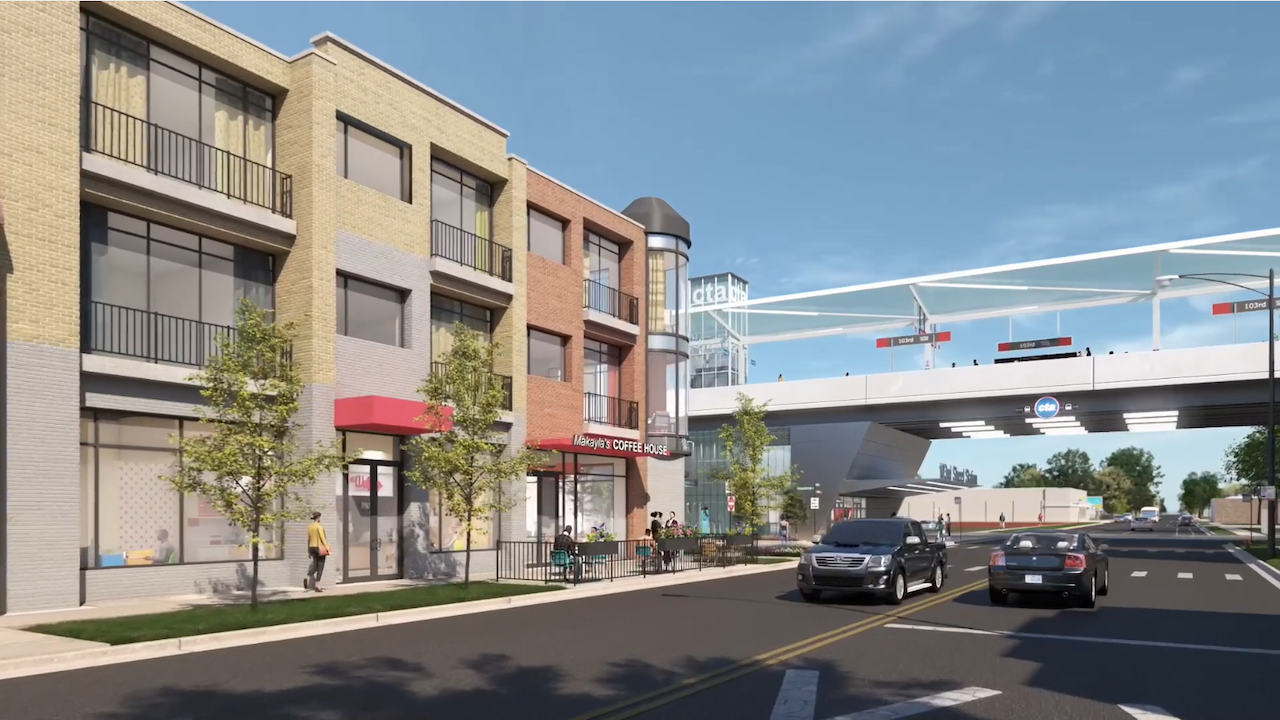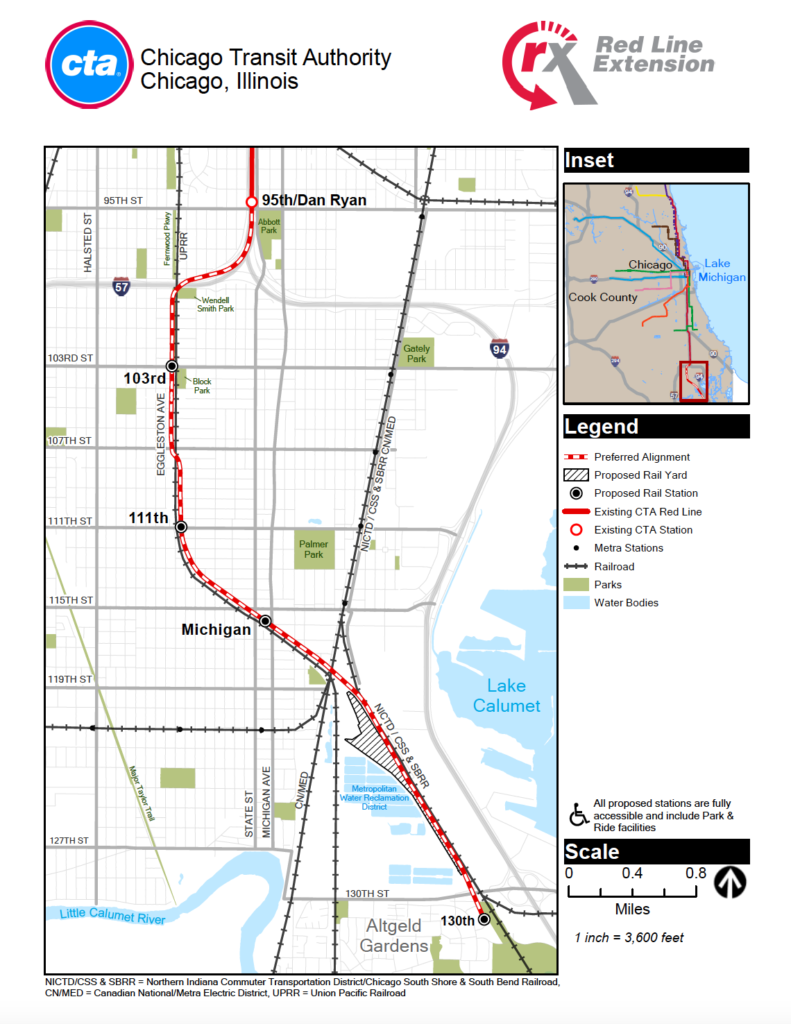
Transit Briefs: CTA, Sound Transit, SamTrans/Caltrain, MassDOT/Amtrak
Written by Carolina Worrell, Senior Editor
Conceptual rendering of the RLE area redevelopment near 103rd Street station. (CTA)
The Chicago Transit Authority (CTA) begins seeking contractor qualifications for Red Line Extension (RLE) project. Also, Sound Transit takes over ownership of Seattle tunnel; SamTrans and Caltrain receive federal funding; and the Massachusetts Department of Transportation (MassDOT) and Amtrak announce that the Valley Flyer passenger service pilot will become permanent.
CTA
The CTA announced Oct. 28 that it is now seeking qualified firms, as part of a two-step procurement process, to design and build the 5.6-mile RLE, which “will provide long-awaited and much needed connection to jobs, education, commerce, and opportunity, while also serving as a catalyst for economic development that benefits the entire City of Chicago.”
The planned $3.6 billion RLE project will extend the Red Line from the existing southern terminal at 95th Street to 130th Street. As part of the RLE project, four new accessible rail stations will be added, plus a new modern, efficient railcar storage yard and maintenance facility that “will benefit users of the entire Red Line,” CTA said.

According to the agency, CTA will issue a Request for Qualifications (RFQ) to select a pool of the most qualified contracting teams that “can demonstrate the ability to design and build the mainline infrastructure and stations portion of the RLE project.”
“Commencing work on the RLE project is dependent on securing funding, however, by beginning this process of pre-qualifying potential contractors now will help expedite overall project development and ensure CTA maintains its timeline to begin construction as early as 2025,” the agency said.
Once a pool of candidate teams is finalized, CTA says it will then invite the potential bidders to submit proposals on how they suggest designing and building the RLE project when the agency issues its Request for Proposals (RFP)–all of which is expected to occur in mid-2023. The proposals, CTA adds, will be considered on a variety of criteria, including experience, price and other factors.
“The Red Line Extension is more than just a transit project, it is a long-overdue investment for Chicago’s Far South Side that will provide benefits that extend to all corners of the City,” said CTA President Dorval R. Carter, Jr. “There’s never been a better time than now to advance such a project, which is why we are full-steam ahead and beginning the lengthy process of seeking out qualified contractors for this complex project so that we can stay on course with the project timeline. The sooner we can award a contract, the sooner we are able to start extending contracting opportunities to small, disadvantaged local businesses and creating good paying jobs for Chicagoans.”
According to CTA, the RLE project is expected to create 6,200 direct construction jobs. CTA says it will host numerous outreach events to encourage participation by Disadvantaged Business Enterprise (DBE)-certified firms and other minority owned firms that wish to participate in the project to meet the DBE goals that will be assessed. Additionally, the project RFP will include a section that requires proposers to describe their plans to reach out to the DBE community and their strategies to meet or exceed the workforce goals that will be established for the project.
Sound Transit
According to a report in The Seattle Times, Seattle’s 1.3-mile transit tunnel will become the property of Sound Transit, which “promises to fix the four worn-out stations for light rail customers.”
Sound Transit’s governing board on Oct. 27 voted 13-0, with five members absent, to take over ownership of the tunnel from King County Metro, The Seattle Times reported.
According to The Seattle Times report, Metro is handing over the tunnel to Sound Transit at “no cost,” but the agency is planning a $96 million investment for upgrades, which include fixing utility lines, broken floors, wall sections and soiled artworks, as well as new escalators and elevators.
According to The Seattle Times, Mayor Harrell “emphasized the tunnel also needs better lighting, graffiti removal and security,” adding that Sound Transit “should be transparent about the task ahead and its obligation to improve rider experience.”
“This is a momentous date, and I join in celebrating and supporting it,” said Mayor Harrell, who is also a member of the transit board, The Seattle Times reported.
According to The Seattle Times report, the Seattle tunnel, which was completed in 1990 for $486 million, initially served specialized Italian buses, which were eventually replaced by hybrid diesel-electric buses, allowing the city to make history with “North America’s only transit tunnel that combined both buses and trains from 2009 and 2019, except for Pittsburgh’s stationless Mount Washington Transit Tunnel.”
According to The Seattle Times report, approximately 570 bus trips moved up to Seattle streets in March 2019, “displaced by convention center construction and growing frequency and ridership light rail.” Since then, the report says, Metro Route 41 to Northgate has been replaced by a light-rail extension.
Now, with help from $87 million in Sound Transit payments, King County’s “original construction debt is paid off–another reason the deal is for zero dollars,” The Seattle Times reported.
According to The Seattle Times report, the two agencies also agreed “to earmark up to $50 million of tunnel advertising revenue to fund low-income fare discounts,” adding that Metro “will continue to operate and maintain the trains as a Sound Transit contractor.”
For the past few years, “travelers constantly complained about broken escalators and elevators, which King County and Sound Transit failed to replace in the 2010s as they neared the end of a 30-year lifespan. Sound Transit took over the conveyances in 2021 with a new maintenance contractor, Schindler,” according to The Seattle Times report.
Their goal, The Seattle Times reported, is “to keep the old parts at least 70% reliable, until all 58 vertical conveyances are replaced. That could take years, with the first eight scheduled at International District/Chinatown Station during winter 2023-24. As of September, the downtown escalators were 71% working, and elevators 85% working, the agency’s tracker says.”
Sound Transit “can’t just fasten new components but must also reengineer the surrounding tunnel area and deliver parts into areas where space can be tight, said Suraj Shetty, executive director of operations,” according to The Seattle Times report.
Downtown’s Westlake Station, formerly “the busiest stop on the 1 Line,” served about 9,600 daily passengers boarding trains as of August, down from its late-2010s peak near 15,000, according to The Seattle Times report. “Overall, 1 Line use is around 80,000 per day and gradually rebounding in 2022. In rebuilding transit ridership, the community must surmount COVID-related health worries, office closures as people work from home, and problems that range from open drug use on downtown sidewalks to a March incident when a man threw a commuting nurse down station stairs,” according to The Seattle Times report.
SamTrans/Caltrain
According to the Metropolitan Transportation Commission (MTC) and as reported in The Daily Journal, out of an $85 allocation of state and federal funding for the region’s 22 transit agencies, $3.83 million will go to Caltrain and $1.46 million will go to SamTrans.
The money, The Daily Journal reported, “is part of a larger financial package allocated in June to fund the MTC’s Transit Transformation Action Plan, a 27-point project that was developed in 2020 by the agency’s Blue Ribbon Transit Recovery Task Force.”
“I’m a big fan of any wayfinding and anything that makes it easier for folks to use our wonderful transit systems,” said Caltrain and SamTrans Director Charles Stone, who also serves on the Belmont City Council, according to The Daily Journal report. “The large issue we confront is usually finding funding for these things, so I am pleased to see MTC is providing this much-needed allocation of dollars.”
According to The Daily Journal report, “the $85 million in funding comes from the 2021 American Rescue Plan Act and the state’s taxes on fuel and diesel fuel. MTC has set aside the money to use it for issues around fare coordination and integration between agencies, regional mapping and wayfinding, and accessibility. According to John Goodwin, assistant communications director with MTC, the distribution was based on a formula of pre-pandemic ridership numbers. Other organizations like BART will receive around $31 million, while the San Francisco Municipal Transportation Agency will receive nearly $27 million. Goodwin said that MTC sent out some money in September, with some small amendments to the overall funding package at an Oct. 12 MTC programming and allocation committee meeting.”
“This is an ongoing process, but the overall numbers for SamTrans and Caltrain and others will remain constant,” Goodwin said, according to The Daily Journal report.
MassDOT/Amtrak
MassDOT and Amtrak announced Oct. 28 that the pilot Valley Flyer passenger service will become permanent with seven day a week service and connections in New Haven Union Station, “allowing convenient travel between Western Massachusetts, central Connecticut and New York City.” The announcement was made in Northampton as the station platform was dedicated in memory of former State Representative Peter V. Kocot, who served in the Massachusetts Legislature from 2001 to 2018.
Amtrak, in conjunction with MassDOT, has been running Valley Flyer trains seven days a week along the Connecticut River, using a rail line referred to as the Knowledge Corridor, with trains making station stops in Springfield, Holyoke, Northampton and Greenfield. The travel option, MassDOT says, “is an extension of Amtrak’s New Haven to Springfield service and offers residents and visitors of Western Massachusetts a more frequent and convenient way to connect with Amtrak’s Northeast Corridor (NEC) at New Haven and reach stations between New Haven and Springfield.”

According to MassDOT, the Valley Flyer is an intercity service “designed to increase the Pioneer Valley’s access to the New York metropolitan area and other points on the NEC.” The service, which was initially offered as a pilot program recommended in the 2018 Massachusetts State Rail Plan, began on Friday, Aug. 30, 2019, and was reduced during the pandemic, before resuming the full schedule on July 19, 2021. The Valley Flyer has two round-trip trains on weekdays, and one round-trip train on Saturdays and Sundays.
Ridership on the Valley Flyer has been strong during the past year, MassDOT said, adding that “although demand for passenger rail service across the Northeast is reduced from pre-pandemic conditions, the Valley Flyer has continually exceeded expectations, including meeting projected ridership and matching Amtrak service along the NEC on its return to pre-pandemic demand.”
According to MassDOT, the Valley Flyer, which primarily serves passengers traveling from Western Massachusetts to New York, is on track to provide 24,000 annual trips for Fiscal Year 2023.
Over the past few years Amtrak says it has been working closely with MassDOT and the other New England states to improve service in the region. Recent advances include restoration of the pre-COVID-19 schedule on the Amtrak Hartford Line service to Springfield in April 2022; extension of the Ethan Allen service to Burlington, Vt., in July 2022; and implementation of the Berkshire Flyer this past summer, a pilot seasonal weekend service between New York City and Pittsfield.
“We launched the Valley Flyer with our partners at MassDOT with the expectation it would become permanent, and we are delighted that our joint vision has come to fruition,” said Amtrak Vice President State Supported Services Ray Lang. “We thank our customers for riding with us as their demand for train travel has helped provide numerous benefits to Western Massachusetts communities, residents and visitors.”
The Northampton Train Station platform, located downtown at 170 Pleasant Street, was dedicated Oct. 28 in memory of former State Rep. Kocot, who died at the age of 61 on February 21, 2018, after a brief illness. According to MassDOT, Kocot represented the First Hampshire District, which includes the communities of Montgomery, Hatfield, Southampton, Westhampton and Northampton.


